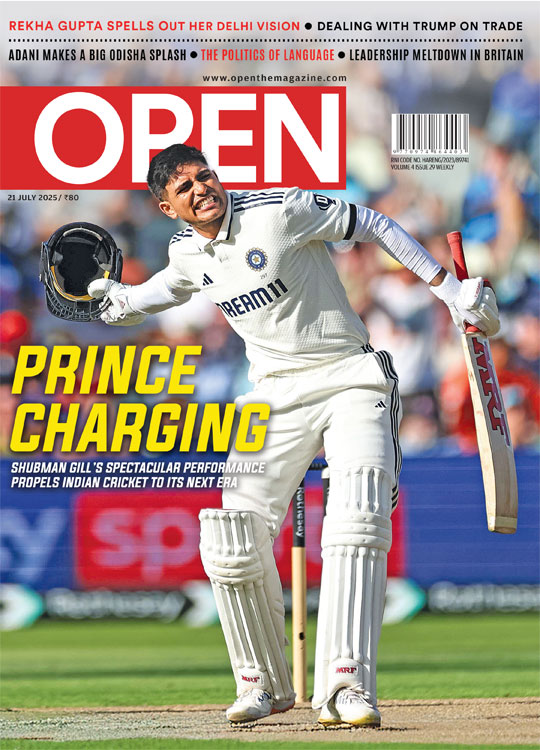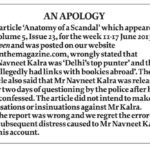Congress in Revival Mode?
Congress has turned aggressive as Rahul Gandhi prepares to take full command later this year, but old rhetoric and internal rifts hold the party back
 Kumar Anshuman
Kumar Anshuman
 Kumar Anshuman
|
02 Jul, 2015
Kumar Anshuman
|
02 Jul, 2015
/wp-content/uploads/2016/01/18990.revivalmode1.jpg)
On 17 June, Padmavati Resort in Udaipur, Rajasthan, was abuzz with Congress activity. All the senior state leaders of the party were staying there, and had over the previous two days been meeting party workers and travelling around the Mewar region. This was for the first time a Congress state working committee meeting was to take place at a location other than Jaipur with Sachin Pilot, president of the Rajasthan Congress, at the helm. At around 9 am, Pilot, along with other party leaders—including Gurudas Kamat, general secretary, and Rameshwar Dudi, leader of opposition in the State Assembly—left for Rotary Bajaj Bhawan, the venue of the meeting. His mobile rang as he was about to step out of his car. At the other end was Randeep Surjewala, in charge of the party’s communication department in Delhi, asking if he could be in the national capital for a press briefing at noon that very day. It was very short notice, and Pilot explained that he had a state-level meeting to hold. The Delhi briefing was pushed forth by a couple of hours for him to finish his Udaipur meeting.
Taking a special flight along with Kamat and Dudi, Pilot was in Delhi by 2 pm , all set to attack Vasundhara Raje, Chief Minister of Rajasthan, over her alleged links with Lalit Modi. Pilot also announced a Congress demonstration in Jaipur the next day that would demand Raje’s resignation. In the two weeks since, Pilot has put up similar dharnas in every district of the BJP-ruled state to up the pressure, even making it a rallying point for the upcoming polls to 129 local bodies in Rajasthan.
Pilot is not alone in his effort to revive his party’s fighting spirit. The current Lalit Modi controversy has given enough ammunition to the Congress, which has struggled for a year since it lost power at the Centre, to find an issue on which to question the BJP-led Government.
The Congress is trying to extract all it can from the episode to reclaim its role of opposition. Senior leaders are making themselves available for party work again, and voices of dissent have gone silent. Digvijaya Singh, general secretary of the Congress, refutes the charge that the party was invisible as an opposition. “As a responsible opposition, we gave time to the incumbent Government to deliver on the promises made during the election of 2014,” he claims, “It is now that we have decided to take on their work over the last one year.”
Yet for the Congress, according to Sanjay Kumar, professor at Centre for the Study of Developing Societies (CSDS), New Delhi, it is only a momentary gain. “The current assertion of Congress has more to do with the BJP than Congress itself,” he says, “It is good to dominate the prime time debates of news channels, but the challenge remains as the Congress needs to take its fight beyond TV studios.”
Undoubtedly, the Congress is making the most of an opportunity that has come its way. But senior leaders believe that the party’s newfound energy owes much to party Vice-President Rahul Gandhi, who was being criticised by some of them for his lacklustre approach not so long ago. Ever since he has returned from his 56- day sabbatical that had left his party squirming to explain it, the 45-year-old Congress heir apparent has been trying to grab public attention by keeping up an attack on BJP Prime Minister Narendra Modi. “I am happy that he is active now, more than what we had expected of him,” says Digvijaya Singh, who earlier expressed unhappiness over Gandhi’s absence at a time when the crucial Budget Session of Parliament was underway.
Made inside Parliament or outside, Gandhi’s remarks have been getting the kind of traction they did not earlier. His ‘Suit boot ki sarkar’ jibe not only stuck, it has become the party line against the Modi Government. “Of course it encourages the party cadre when they see their leader in action,” says Ambika Soni, general secretary of the Congress. “You see a new crop of young leaders emerging under his leadership who are ready to fight on the streets,” she adds.
This is not the same Rahul Gandhi who avoided questions and maintained a distance from the media. His recent speeches suggest a change in attitude. He gets involved in discussions, listens to others in Parliament and responds quickly. Several Congress leaders Open spoke to confirm that this is all part of a newly worked-out plan. “Some suggestions have already been implemented,” says a party general secretary. “That includes improving the PR machinery and focusing on him as a future leader.”
The tenure of Congress President Sonia Gandhi comes to an end later this year, and the stage has been set for her son to take over the party’s leadership. An all-India membership drive is to be followed by organisational polls in September. Sources reveal that this would be when Rahul Gandhi ascends to the party’s top as its president, and an AICC plenary session would formalise his leadership. “It is something that every Congress worker wants now,” says Kamat. “Surely, he will choose his own team after his election as president.” A few months ago, some senior leaders such as Captain Amarinder Singh who were opposed to the idea of his elevation to the party’s top post, but such voices have softened considerably.
The communication team under Surjewala looks far better organised than before. It responds to issues with alacrity and likes to engage the media. Senior leaders are roped in to explain details, and they too appear on quick notice. Senior party leader Ghulam Nabi Azad, who is Leader of the Opposition in the Rajya Sabha, was approached to address the media on 22 June just the previous evening. He duly appeared with Jairam Ramesh and briefed mediapersons. “It was rare to see him come to the party office, leave alone addressing a conference,” says a senior AICC official.
Beyond all this, there is a separate worksheet for Rahul Gandhi too. The points to be made in his speeches are well prepared and discussed with a closed group of senior leaders, and he is supplied with the required support material. His tours and ‘padyatras’ are chalked out in advance, and route suggestions are taken from state units instead of one- way notices being issued from his office. Special coordinators are deputed for the job and the media is kept informed.
Sometimes, other tactics are used. On 12 June, Gandhi was to meet sanitation workers in Delhi. On the instructions of Delhi Congress President Ajay Maken, the plan was kept under wraps. Gandhi, arriving at the East Delhi location where these workers were on strike, mounted an attack on the Centre and Delhi’s government for not paying them their salaries. Within minutes, Delhi’s Lieutenant Governor Najeeb Jung announced a release of Rs 493 crore, and the Congress was only too pleased to take the credit for it. “Had the media been informed in advance, the fund could have been released before his visit,” says a party leader who was aware of the ploy.
To reach out to farmers faced with an agrarian crisis, Gandhi has undertaken four padyatras and one train journey. On a trip to Punjab, he had met one Surjit Singh on 28 April, a farmer who committed suicide on 10 June. Senior leaders and the communication team suggested that he visit the farmer’s family, and he was quick to accept it. On 19 June, he reached Fatehgarh Sahib to meet the grieving family with former Congress MP Vijay Inder Singla. Even the state party unit was informed only after he had left Delhi.
Going by the results of the 2014 General Election, Rahul Gandhi’s earlier approach was rejected roundly by voters. Now, while his manner may appear different, his basic style of politics does not seem to have changed. In the past, he would always position himself as an agitator who is fighting the system, even as he tried to mingle with farmers, the poor and downtrodden. His recent speeches on farmer distress are not very different from his words of 2011, when he spoke in Bhatta Parsaul village near Greater Noida in Uttar Pradesh. Could it work now? “I think the Land Acquisition ordinance was the first mistake by the current Government, which gave recognition to his style of politics,” says Zoya Hasan, a former JNU professor who has been following Congress politics for long. “It looks like his appeal is now being heard by farmers [whose earnings] are marred by a bad crop and are scared of their land being taken away by the Government.”
Gandhi doesn’t let go of chances to be critical of India’s wealthy, especially industrialists. As he portrays it, there is a divide between Bharat and India, and he is on the side of Bharat. He routinely targets the corporate class for its association with Modi. Recently while addressing a tribal gathering in Chhattisgarh, he mentioned his visit to a mine in Australia and how the workers there were in bad shape after giving up their land. Can a national party aspiring to regain power afford to take an anti-modernisation stand? This is what critics ask. “We are not against industries,” responds Digvijaya Singh, “[Gandhi] names few industrialists who are being given an unfair advantage.” According to Kumar of CSDS, “Elections are far away. There is no harm in buttering up one large section of society at the cost of the other. This is what the BJP was doing as well.”
Hasan feels that the Congress’ biggest challenge is to make headway with the middle-class that has more or less given up on the party. “At times, the Congress has taken a right-of-centre approach. But with a strong right-wing party in power, it is left with no option but to take a left-of-centre stand,” she says. This, however, could further alienate India’s middle-class and urban voters who had voted Congress in 2009. As India develops, it is hard to see how a political party can ignore the middle-class and only play the poverty card. “They are the opinion makers and they play a vital role in any government,” says Hasan, “Congress seriously needs to think about the middle-class.”
The Congress also needs to regain strength in several populous states, most importantly Bihar and Uttar Pradesh. “It is very difficult for it to make inroads in these states,” says Kumar. “There is nothing for the Congress in Bihar’s upcoming elections. Also, in states where the party has fallen to third or fourth position, a comeback looks difficult.” The party is trying hard to adapt to ground reality. Gandhi’s old policy of going it alone in such polls has not paid off well. This time, he met Nitish Kumar to put pressure on Lalu Prasad for an alliance, and it has materialised. Similar arrangements might be made for UP’s Assembly polls. “If you see the BJP, they have become stronger by making alliances. Now we would follow the same,” says a senior Congress leader. An alliance in West Bengal may also be forged for the 2016 Assembly elections there.
However, in states where the Congress is in power or in a position to come back, internal conflicts are its big bane. The party is divided in Assam and Punjab. In the latter, the Amarinder Singh faction wants control of the state unit and he makes no secret of his ambitions. “Rahulji listens to workers and takes decisions accordingly. Conflict takes place when there is hope for a better performance,” says Ambika Soni, who is the party’s general secretary in charge of Punjab.
In all, the next two years would be crucial for the Congress and Rahul Gandhi as its leader. “For a party which has just hit rock-bottom in the Lok Sabha polls, it is too early to talk of a revival,” says Hasan. “It remains to be seen how Rahul Gandhi responds to upcoming political situations.”
About The Author
CURRENT ISSUE
MOst Popular
3

/wp-content/uploads/2025/07/Cover-Shubman-Gill-1.jpg)











More Columns
Why India's Rich And Famous Choose To Settle Abroad Short Post
‘Fuel to Air India plane was cut off before crash’ Open
Shubhanshu Shukla Return Date Set For July 14 Open